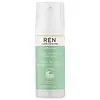What's inside
What's inside
 Key Ingredients
Key Ingredients

No key ingredients
 Benefits
Benefits

 Concerns
Concerns

 Ingredients Side-by-side
Ingredients Side-by-side

Water
Skin ConditioningCetearyl Alcohol
EmollientCamellia Oleifera Seed Oil
Skin ConditioningCetearyl Ethylhexanoate
EmollientMyristyl Myristate
EmollientSesamum Indicum Seed Oil
EmollientGlycerin
HumectantButyrospermum Parkii Butter
Skin ConditioningCaprylic/Capric Triglyceride
MaskingTriheptanoin
Skin ConditioningCetearyl Glucoside
EmulsifyingMyristyl Laurate
Oryzanol
Skin ConditioningHelianthus Annuus Seed Oil
EmollientEthylhexylglycerin
Skin ConditioningVaccinium Macrocarpon Seed Oil
Skin ConditioningBisabolol
MaskingRibes Nigrum Seed Oil
EmollientCarbomer
Emulsion StabilisingHippophae Rhamnoides Fruit Extract
Skin ConditioningCitrus Nobilis Peel Oil
MaskingTocopherol
AntioxidantAnthemis Nobilis Flower Oil
MaskingCinnamomum Camphora Linalooliferum Leaf Oil
PerfumingPelargonium Graveolens Flower Oil
MaskingPhenoxyethanol
PreservativeSodium Dehydroacetate
PreservativePueraria Lobata Symbiosome Extract
AntioxidantLaminaria Ochroleuca Extract
Skin ConditioningCassia Alata Leaf Extract
AstringentCalendula Officinalis Flower Extract
MaskingGlucose
HumectantParfum
MaskingRosmarinus Officinalis Leaf Extract
AntimicrobialLactic Acid
BufferingSodium Hydroxide
BufferingCitronellol
PerfumingGeraniol
PerfumingLimonene
PerfumingLinalool
PerfumingWater, Cetearyl Alcohol, Camellia Oleifera Seed Oil, Cetearyl Ethylhexanoate, Myristyl Myristate, Sesamum Indicum Seed Oil, Glycerin, Butyrospermum Parkii Butter, Caprylic/Capric Triglyceride, Triheptanoin, Cetearyl Glucoside, Myristyl Laurate, Oryzanol, Helianthus Annuus Seed Oil, Ethylhexylglycerin, Vaccinium Macrocarpon Seed Oil, Bisabolol, Ribes Nigrum Seed Oil, Carbomer, Hippophae Rhamnoides Fruit Extract, Citrus Nobilis Peel Oil, Tocopherol, Anthemis Nobilis Flower Oil, Cinnamomum Camphora Linalooliferum Leaf Oil, Pelargonium Graveolens Flower Oil, Phenoxyethanol, Sodium Dehydroacetate, Pueraria Lobata Symbiosome Extract, Laminaria Ochroleuca Extract, Cassia Alata Leaf Extract, Calendula Officinalis Flower Extract, Glucose, Parfum, Rosmarinus Officinalis Leaf Extract, Lactic Acid, Sodium Hydroxide, Citronellol, Geraniol, Limonene, Linalool
Water
Skin ConditioningParaffinum Liquidum
EmollientStearic Acid
CleansingGlyceryl Stearate
EmollientTriethanolamine
BufferingCera Alba
EmollientCetyl Palmitate
EmollientButyrospermum Parkii Butter
Skin ConditioningSteareth-10
EmulsifyingPolyacrylamide
C13-14 Isoparaffin
EmollientLaureth-7
EmulsifyingPropylene Glycol
HumectantHydrolyzed Soy Protein
HumectantAloe Barbadensis Sprout
Humectant1,2-Hexanediol
Skin ConditioningCaprylyl Glycol
EmollientTropolone
Skin ConditioningParfum
MaskingWater, Paraffinum Liquidum, Stearic Acid, Glyceryl Stearate, Triethanolamine, Cera Alba, Cetyl Palmitate, Butyrospermum Parkii Butter, Steareth-10, Polyacrylamide, C13-14 Isoparaffin, Laureth-7, Propylene Glycol, Hydrolyzed Soy Protein, Aloe Barbadensis Sprout, 1,2-Hexanediol, Caprylyl Glycol, Tropolone, Parfum
 Reviews
Reviews

Ingredients Explained
These ingredients are found in both products.
Ingredients higher up in an ingredient list are typically present in a larger amount.
This ingredient is also known as shea butter. It is an effective skin hydrator and emollient.
Emollients help soothe and soften your skin. It does this by creating a protective film on your skin. This barrier helps trap moisture and keeps your skin hydrated. Emollients may be effective at treating dry or itchy skin.
Shea butter is rich in antioxidants. Antioxidants help fight free-radicals, or molecules that may harm the body. It is also full of fatty acids including stearic acid and linoleic acid. These acids help replenish the skin and keep skin moisturized.
While Shea Butter has an SPF rating of about 3-4, it is not a sunscreen replacement.
Shea butter may not be fungal acne safe. We recommend speaking with a professional if you have any concerns.
Learn more about Butyrospermum Parkii ButterParfum is a catch-all term for an ingredient or more that is used to give a scent to products.
Also called "fragrance", this ingredient can be a blend of hundreds of chemicals or plant oils. This means every product with "fragrance" or "parfum" in the ingredients list is a different mixture.
For instance, Habanolide is a proprietary trade name for a specific aroma chemical. When used as a fragrance ingredient in cosmetics, most aroma chemicals fall under the broad labeling category of “FRAGRANCE” or “PARFUM” according to EU and US regulations.
The term 'parfum' or 'fragrance' is not regulated in many countries. In many cases, it is up to the brand to define this term.
For instance, many brands choose to label themselves as "fragrance-free" because they are not using synthetic fragrances. However, their products may still contain ingredients such as essential oils that are considered a fragrance by INCI standards.
One example is Calendula flower extract. Calendula is an essential oil that still imparts a scent or 'fragrance'.
Depending on the blend, the ingredients in the mixture can cause allergies and sensitivities on the skin. Some ingredients that are known EU allergens include linalool and citronellol.
Parfum can also be used to mask or cover an unpleasant scent.
The bottom line is: not all fragrances/parfum/ingredients are created equally. If you are worried about fragrances, we recommend taking a closer look at an ingredient. And of course, we always recommend speaking with a professional.
Learn more about ParfumWater. It's the most common cosmetic ingredient of all. You'll usually see it at the top of ingredient lists, meaning that it makes up the largest part of the product.
So why is it so popular? Water most often acts as a solvent - this means that it helps dissolve other ingredients into the formulation.
You'll also recognize water as that liquid we all need to stay alive. If you see this, drink a glass of water. Stay hydrated!
Learn more about Water